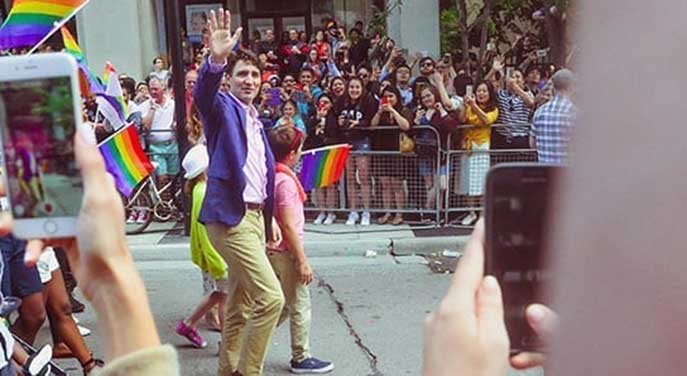 The first day of Canada’s Election#44 campaign involved critics accusing Prime Minister Trudeau of selfishly calling an election as a vanity project seeking a majority government. The prime minister naturally rejected that allegation, noting that pivotal decisions need to be made as Canada emerges from the pandemic, suggesting voters’ upcoming decision would be “maybe the most important since 1945.”
The first day of Canada’s Election#44 campaign involved critics accusing Prime Minister Trudeau of selfishly calling an election as a vanity project seeking a majority government. The prime minister naturally rejected that allegation, noting that pivotal decisions need to be made as Canada emerges from the pandemic, suggesting voters’ upcoming decision would be “maybe the most important since 1945.”
The election, he said, was his way of providing Canadians with their chance “to help decide where our country goes from here.”
Is the choice really that stark? Is this simply the citizenry deciding on competing applicants for prime minister, or are elections really a chance to shape the country’s future?
Only a few federal elections in Canada have focused on a single significant policy choice: the 1878 National Policy and building of a railway, the 1917 election regarding conscription and the First World War, and the 1911 and 1988 elections relating to trade with the Americans are four prominent exceptions that come to mind.
However, most of our elections are much less defining (at least as they were understood at the time; history always provides a 20/20 perspective.) Going to the ballot box in Canada usually provides citizens with a choice either to continue an established basic policy direction or to “throw the bums out.” For most of Canadian history, changes in government have been a replacement of decision-makers but not a radical change in direction. The major parties have generally agreed about the destination but differed on which road to take or how fast to get there.
 The day after Stephen Harper won a minority government in 2006, I penned an analysis suggesting Harper’s election as prime minister marked the end of a “pan-Canadian consensus” that had dominated Canada for decades. (John Ibbitson, among others, proposed a very similar thesis in his 2011 book The Big Shift, which used the label “Laurentian Consensus” to describe what was being replaced.)
The day after Stephen Harper won a minority government in 2006, I penned an analysis suggesting Harper’s election as prime minister marked the end of a “pan-Canadian consensus” that had dominated Canada for decades. (John Ibbitson, among others, proposed a very similar thesis in his 2011 book The Big Shift, which used the label “Laurentian Consensus” to describe what was being replaced.)
Ibbitson argued that Harper’s election had brought a new elite to town, and this was the start of western Canadians and immigrants – with a different set of values and priorities – exercising more muscle in shaping Canada’s future. I was a bit more skeptical, arguing in 2006 that Harper’s coalition had little philosophic coherence and his challenge would be to manage and unite a coalition of diverging interests. The decade of government under Harper’s leadership confirmed that assessment; good management may have been achieved, but relatively little lasting change was embedded.
In a follow-up 2011 piece, Decade of Dissensus, Michael Van Pelt and I suggested that a reorganization of the left would follow the discord on the right. I expected it to take the better part of another decade to sort through how the economics, demographics, regional interests, and politics might interact to provide coherent new answers.
Prime Minister Trudeau has fast-forwarded this process. Underestimated by his critics as “not up to the job,” Trudeau’s government has been far more transformative than many may admit. And beyond the policies of the moment, much of Trudeau’s direction has been institutionalized. Senate reform had long been understood to be an institutional change that might drive how a new Canada might look.
Harper made it a signature commitment, tried to implement change, and was ultimately stymied by the Supreme Court. Trudeau didn’t talk much about it but unilaterally decided to replace partisan appointments with independent senators through a revised appointment process.
The result is a Senate that retains all of its constitutional powers, has lifelong appointments, and has embedded an ideological liberal-progressive institutional influence in our federal polity for decades to come. Senate reform has happened.
Although Prime Minister Harper had the opportunity to appoint seven justices to the Supreme Court during his decade, many conclude that his appointments have not collectively amounted to any significant change in direction for the court. Trudeau has appointed four justices since 2015. And after Justice Moldaver’s scheduled retirement in 2022, there are no mandatory retirements scheduled until 2028. If there is any momentum in the direction of Supreme Court decisions, it is in support of a more progressive polity, not a more conservative one.
Trudeau has arguably governed in a more ideologically progressive manner than any previous Canadian government. He is no slave to institutional or parliamentary traditions; if conventions need to be cast aside for him to achieve his objectives, he is quite ready to do so.
Even before the pandemic, Trudeau was a bold spender without any real consideration for repayment strategies. To be sure, not everyone on the left is a fan, just as many on the right were disappointed in Harper. Still, if both governments were to be described as incrementally heading in a philosophic direction, Trudeau has been taking larger steps.
Election 2021 will not have a singular policy issue like trade or conscription to define it. Frankly, “build back better” is still too vague to catch on with any meaning. Campaigns matter in Canadian politics, but it is too early to pronounce what this election is about.
The opposition parties would like it to be about Trudeau, hoping Canadians will share their dislike of him and punish him for a perception of entitlement. That’s a risky strategy. Trudeau’s opponents have always overestimated public resentment. And whether it is good luck or effective strategy, to date the prime minister has avoided having his mistakes result in electoral dissatisfaction.
Three terms for Prime Minister Harper did not result in significant structural or directional change in Canada. Conservative government did not embed any replacement to the “pan-Canadian” or “Laurentian” consensus. A third term for Prime Minister Trudeau, however, would seem far more likely to result in embedding a lasting direction for the country.
True, he had a head start in sympathetic institutions aligned with his direction. Perhaps because of that, his tenure to date has seen an embedding of institutional and policy direction that any subsequent government will not easily overturn.
Whatever your assessment of the policies and skills of the prime minister, it must be admitted that, for someone who was allegedly not up to the job, he has made significant achievements in support of his policy agenda. The question this campaign will answer is whether Canadians are ready to embrace these changes.
Ray Pennings is Executive Vice President of Cardus.
Ray is a Troy Media Thought Leader. For interview requests, click here.
This commentary was submitted by Convivium, Cardus‘s online magazine. Cardus is a leading think tank and registered charity. Convivium is a Troy Media Editorial Content Provider Partner.
Convivium’s work depends upon the partnership of generous donors who believe in our mission to create a conversation that enhances the role of faith in our common life.
The views, opinions and positions expressed by columnists and contributors are the authors’ alone. They do not inherently or expressly reflect the views, opinions and/or positions of our publication.
© Troy Media
Troy Media is an editorial content provider to media outlets and its own hosted community news outlets across Canada.


